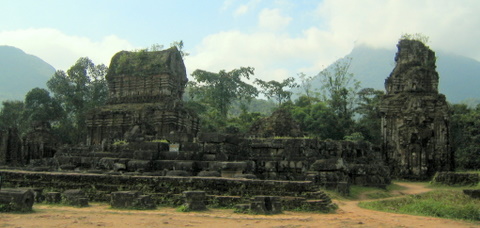|
 My
Son, the former cultural and religious centre of the mighty Champa kingdom, is
located some 70 kilometres south-west of Danang.
The architecture of this intriguing site is considered to be related to
other impressive cities of Indian-influenced civilisations in Southeast Asia,
namely Angkor in Cambodia, Ayuthaya in Thailand, Borobudur in Java Indonesia and
Bagan in Myanmar. My
Son, the former cultural and religious centre of the mighty Champa kingdom, is
located some 70 kilometres south-west of Danang.
The architecture of this intriguing site is considered to be related to
other impressive cities of Indian-influenced civilisations in Southeast Asia,
namely Angkor in Cambodia, Ayuthaya in Thailand, Borobudur in Java Indonesia and
Bagan in Myanmar.
The earliest writings discovered in the My Son
ruins suggested that this site was first built by King Bhadresvara during the 4th
century to worship Siva, an important divinity guarding the Champa king and his
kingdom. It is believed that this
first construction was mainly of wood which was later destroyed by a casualty of
fire two centuries later.
 The
beginning of 7th century saw King Sambhuvarman re-building the
religious centre in My Son. Unlike
his predecessor, King Sambhuvarman decided to use more durable materials such as
baked bricks to ensure that the construction could withstand the passage of
time. Different religious towers were added to My Son over a period
between 7th to 13th century, making it the most important
architectural centre of the Champa kingdom. The
beginning of 7th century saw King Sambhuvarman re-building the
religious centre in My Son. Unlike
his predecessor, King Sambhuvarman decided to use more durable materials such as
baked bricks to ensure that the construction could withstand the passage of
time. Different religious towers were added to My Son over a period
between 7th to 13th century, making it the most important
architectural centre of the Champa kingdom.
The My Son ruins was first discovered by a French
archaeologist, M.C. Paris, in 1898. Today,
Vietnamís most distinguished centre of the earlier Champa kingdom is yet
another UNESCO World Cultural Heritage Site.
|